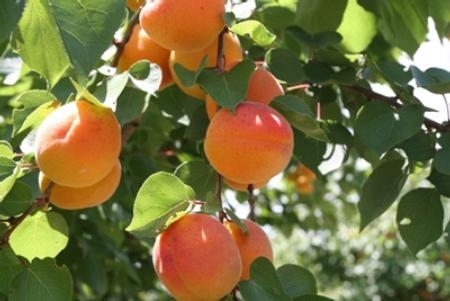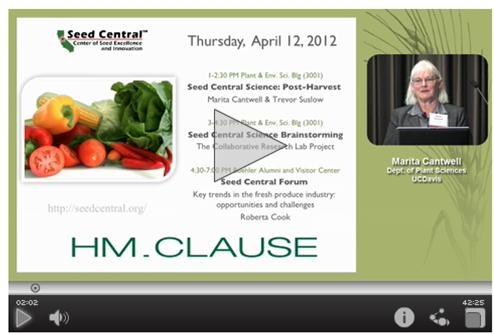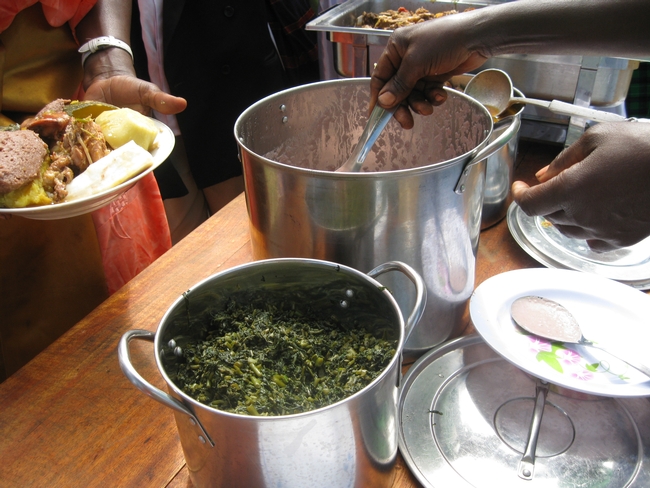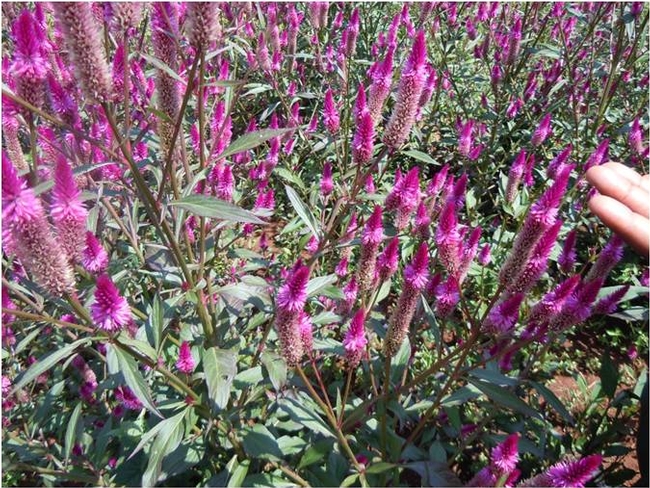UC Food Blog
Arrival of apricot season
The brief season of apricot harvest is upon us, and many fruit enthusiasts will soon bite into one of these small, delicate, yellowish-orange fruits. I grew up in a San Jose subdivision that was built on an apricot orchard. Each house had 2 or 3 apricot trees left on the lot, and so I have great memories of enjoying them fresh from the tree, still warm from the sun and tartly sweet . But, I have to admit that my favorite form of apricot then and now, are home-dried apricots. They sure were a great treat to find nestled in my trusty red-plaid metal lunchbox in the middle of winter.
Apricots have been grown in the fertile crescent of Persia for thousands of years. The colonists brought the apricot to North America, but most of the stock of today’s production comes from seedlings carried by the Franciscan friars who built the missions and brought much of Spain’s agriculture to California.
In recent years I have heard many disappointed comments at that first bite of a fresh apricot, and I was curious to check with University of California pomologists and USDA Agricultural Research Station specialists to see what progress was being made in bringing more flavorful apricots to consumers. Five different pomologists indicated that market produce buyers tend to primarily value color, size and firmness over the flavor of apricots. The earlier the produce buyers can get them into the grocery store, the more highly they are valued, so they are often harvested before the fruit’s flavor has a chance to develop. The experts I checked with all said they NEVER bought apricots anywhere except a farmer’s market or roadside stand.
The varieties most commonly grown in California are “Patterson”, “Tilton” and “Apache,” and they are selected by growers because of their early harvest dates, large size, attractive color, longer shelf life, and their ability to be used for either fresh or canning applications. Tom Gradziel, a UC Davis professor of genetics and breeding of the Prunus species said, “In the Central Valley, most apricots are still going for processing. Therefore a dual market (processing or fresh) variety such as Patterson is often preferred. It has excellent color, size, and firmness, but tastes like cardboard."
The varieties that the pomologists included in their list of favorites are “Royal Blenheim,” “Robada,” “Katy,” “Primarosa” and “Derby.” Craig Ledbetter, a geneticist working with apricot breeding at the Parlier USDA Agricultural Research Service Center said, “We hear so much about flavor, but I don’t think flavor will be coming to the grocery stores unless in the form of overripe fruit. Here we breed for a sugar/acid balance. We have many breeding selections that taste absolutely fabulous, but are a bit smaller than growers desire. Honestly, they don’t even want to look at ‘small’ fruit. It is a pity!”
Selecting apricots. Apricots do not develop more flavor after they are picked, so select fruit that are completely yellow, deepening toward orange. The subtle, sweet scent of apricot is a good indicator that the inside will taste just as good.
Storing apricots. Keep them on the counter if you will eat them within 2 to 3 days, otherwise store ripe apricots in the refrigerator in a perforated plastic bag.
How to enjoy apricots. Apricots have a pit in the center that is easily separated from the flesh. After washing the fruit, cut in half along the seam and remove the pit. Enjoy the whole fruit, or prepare in tarts, breads, jams, glazes for meats, salsa, or dry them in a dehydrator.
Apricot Tart
Pastry.
1 ¼ c. all-purpose flour
½ tsp. salt
1 Tbls. granulated sugar
½ tsp. almond flavoring (optional)
½ c. unsalted butter, chilled
2 Tbls. Ice water
Using a pastry blender, stir together flour, salt and sugar, cut in butter until dough is in coarse crumbs. Cut in water until pastry holds together when pinched, do not over mix. Lay out a sheet of plastic wrap, form pastry into a ball and wrap with the plastic wrap. Refrigerate 60 minutes. Remove plastic wrap and place on lightly floured surface, roll out to a 12” – 14” circle. Place on a baking tray lined with parchment paper, and return to the refrigerator while preparing the apricot filling.
Apricot filling.
½ c. granulated sugar (or less if the apricots are sweet)
1 Tbls. cornstarch
Dash of salt
1 ½ lbs. (or 10 medium-large) fresh, ripe apricots, pitted and sliced into 1/4” slices
Place sugar, cornstarch and salt into a bowl and stir well, add sliced apricots and toss gently.
Remove pastry from the refrigerator, place apricot filling in the center of the pastry, leaving a 2” border around the edge. Gently fold the pastry border up on top of the apricots, folding the pastry up around the outside edges of the fruit and pinching folds to form a round tart. Seal any cracks in the sides and bottom of the pastry so the juice doesn’t leak out on the baking sheet. Leave the fruit showing in the center of the pastry. Sprinkle with a handful of sliced almonds if desired.
Bake at 375 degrees F for 40-45 minutes, or until golden brown.
Excellent served with vanilla ice cream.
University of California Resources:
- Recommendations for Maintaining Postharvest Quality of Apricots
- Storing Fresh Fruits and Vegetables for Better Taste
- Apricot Information: Fruit & Nut Research and Information Center
Did you catch the buzz?
Did you catch the buzz?
It's still a troubling scene for our nation's honey bees, but it appears that the total losses for the 2011-2012 winter aren't as bad as they could be.
In other words, managed honey bee colonies appear to be holding their own. Overall, they didn't take a sharp dive last winter.
The annual survey, conducted by the U.S. Department of Agriculture (USDA), the Bee Informed Partnership, and the Apiary Inspectors of America shows that the honey bee colony losses averaged 30 percent for the winter of 2011-2012.
Compare that to 34 percent for the 2009-2010 winter, 29 percent for 2008-2009 winter; 36 percent for 2007-2008, and 32 percent for 2006-2007.
Kim Kaplan of the Agricultural Research Service (ARS) of USDA wrote in a May 23 news release that 5,572 beekeepers responded to the survey, which covered the period from October 2010 to April 2011. These 5,572 beekeepers, he said, manage more than 15 percent of the country's estimated 2.68 million colonies.
As ARS entomologist Jeff Pettis, who helped conduct the study, said: "The lack of increase in losses is marginally encouraging in the sense that the problem does not appear to be getting worse for honey bees and beekeepers."
Pettis is a familiar name among scientists, beekeepers and the beekeeping industry. He leads the USDA's chief research agency, the Bee Research Laboratory, in Beltsville, Md.
ARS plans to publish a complete analysis of the data later this year, Kaplan reports, but for now, we know that the average losses didn't fall below 30 percent. Some beekeepers, however, recorded much heavier losses.
Why care about the declining bee population?
As author Norm Gary, emeritus professor of entomology at UC Davis, says in his book, Honey Bee Hobbyist; The Care and Keeping of Bees, "Bees play a fundamental role in food production. About one-third of the food we eat, at least in the United States, can't be produced without pollination by honey bees. Fruits, vegetables, berries, some fiber crops, domestic animal feed, and oil seed crops would be in extremely short supply without honey bee pollination."
And almonds. California, the world's largest producer of almonds, has some 800,000 acres of almonds and each acre requires two hives for pollination. Without bees, no almonds.
"Can you imagine the impact on our food supply and diet if honey bees weren't available for pollination?" Gary asks. "Without them, the human diet would consist mostly of grains and fish."
Think wheat, rice and fish.
No honey, either.
Speaking of honey, you might like to try this Cranberry Oat Bread recipe provided by the National Honey Board. It hasn't been a honey of a winter for the nation's bees, but this is a honey of a recipe.
Cranberry Oat Bread
3/4 cup honey
1/3 cup vegetable oil
2 eggs
1/2 cup milk
2-1/2 cups all-purpose flour
1 cup quick-cooking rolled oats
1 teaspoon baking soda
1 teaspoon baking powder
1/2 teaspoon salt
1/2 teaspoon ground cinnamon
2 cups fresh or frozen cranberries
1 cup chopped nuts
Combine honey, oil, eggs and milk in large bowl; mix well. Combine flour, oats, baking soda, baking powder, salt and cinnamon in medium bowl; mix well. Stir into honey mixture. Fold in cranberries and nuts. Spoon into two 8-1/2 x 4-1/2 x 2-1/2-inch greased and floured loaf pans.
Bake in preheated 350 degrees oven 40 to 45 minutes or until wooden toothpick inserted near center comes out clean. Cool in pans on wire racks 15 minutes. Remove from pans; cool completely on wire racks. Makes 2 loaves.

Honey bee heading toward pomegranate blossom. (Photo by Kathy Keatley Garvey)

Honey bee packing pollen while foraging on almond blossoms at the Harry H. Laidlaw Jr. Honey Bee Research Facility, UC Davis. (Photo by Kathy Keatley Garvey)
Postharvest specialists share their expertise at 'Seed Central'
Aiming to energize the seed industry cluster surrounding UC Davis, Seed Central, an initiative of the Seed Biotechnology Center at UC Davis and SeedQuest, recently highlighted postharvest handling and food safety at their monthly forum. Recordings of invited guest speakers, Marita Cantwell, Trevor Suslow and Roberta Cook, UC Cooperative Extension specialists with expertise in post harvest science, show the passion they feel for their respective subjects and why we're fortunate to have them on our team. Cantwell and Suslow are in the UC Davis Department of Plant Sciences; Cook is in the UC Davis Department of Agricultural and Resource Economics.
Cantwell, a postharvest physiologist, specializes in handling and storage of intact and fresh-cut vegetables. In her talk, she describes the Postharvest Technology Center itself and gives an overview of the handling challenges of many vegetable varieties.
A plant pathologist, Suslow’s program centers on studying the effects of microflora on the postharvest quality of perishable produce. With much attention to current food safety a priority, Suslow’s produce safety overview and specific case examples help us all (ahem) digest this hot topic.
Cook, an agricultural economist, focuses on fresh produce marketing and food distribution. This presentation centers on North American vegetable markets. Even if you’re not a grower, shipper or retailer, Cook's description of trends in the produce industry are fascinating — we all eat fruits and vegetables every day. She talks about things we might not ever think about.
More African vegetables on more plates
What will be the new food frontier? An article in the Wall Street Journal with the headline “Next Stop for Food Fanatics: Africa” predicts adventurous American palates may soon be craving sub-Saharan cuisines.
Have you heard of these?
- Nakati (Solanum macrocarpon, S. aethiopicum) Also called African eggplant, some types of nakati are eaten for their leafy greens, while others are eaten for their fruit (which can look like a tomato or eggplant).
- Cowpea leaves (Vigna unguiculata) This plant produces black-eyed peas, but the greens of the plant can also be eaten as a vegetable.
- Bbuga (Amaranthus Gracecizans) You might know this plant by its common American name: pigweed.
- Doodo (Amaranthus Dubius) Like bbuga, this type of amaranth is eaten for its leaves in many parts of Africa. In North and South America, varieties of amaranth are usually used as a grain.
- Jjobyo (Gynandropsis Gynandra, Cleome gynandra) Also called spider plant.
Many of these indigenous vegetables are rich in micronutrients such as iron, vitamin A and vitamin B. When it comes to alleviating malnutrition in developing countries of eastern Africa, indigenous vegetables offer workable solutions because they are not only nutritious, but also familiar to the region’s eaters and farmers.
But research into these vegetables has often not been a priority, even among international development professionals. Markets for these vegetables are also largely undeveloped because they are widely considered subsistence crops, often grown in small garden plots by women for their own families. But growing these crops commercially can mean increased income for smallholder farmers and improved nutrition for consumers who crave traditional foods.
Recently U.S. researchers have been working with indigenous crops like these in east African countries — with funding and support from the Horticulture Collaborative Research Support Program (Horticulture CRSP), led by Beth Mitcham at UC Davis with funding from USAID. In Kenya, Tanzania and Zambia, Stephen Weller of Purdue University is leading a Horticulture CRSP research project on production practices, seed resources, postharvest handling, marketing and nutrition of varieties of amaranth, spider plant and African nightshade.
In Uganda, Kate Scow of UC Davis is partnering with local groups to try out a new model of extension while increasing production of indigenous greens, such as nakati, bbuga and jjobyo.
Take a look at this short video for a little more background:
Just as bok choy, an Asian vegetable, has become familiar to many American households, perhaps one day you’ll find nakati or another African leafy vegetable on your plate.
In the meantime, researchers with Horticulture CRSP are working to get more African leafy vegetables into the research agendas, fields, markets and plates of our counterparts in eastern Africa.
Read more abut Horticulture CRSP and its projects around the world at http://hortcrsp.ucdavis.edu.
UC aims to improve economic viability of California blueberry farms
California consumers have grown accustomed to enjoying locally grown blueberries in the last decade. Much of the credit goes to UC Cooperative Extension advisor Manuel Jimenez of Tulare County, who has been studying blueberry production and varieties at the UC Kearney Agricultural Research and Extension Center since 1998.
California’s abundant sunshine enables growers to produce high-quality, very sweet Southern Highbush variety blueberries. But, blueberry plants are difficult and expensive to establish and maintain, in part because of California's soil chemistry.
“Blueberries are adapted to grow in forests, in acidic soils,” Jimenez said. “We’re growing them in a desert in alkaline soil. That requires that we acidify the soil when we establish the crop and continuously acidify the irrigation water – which is very costly.”
For example, a 2009 Blueberry Cost Study produced by UC Davis calculated that equipment needs for acidification - including a storage tank, pump and monitoring kit - amounts to $5,500. In addition, the growers must purchase large quantities of sulfuric acid to add to the soil and irrigation water.
Reducing acidification cost is the goal of a new blueberry trial at Kearney, in which Jimenez has grafted the most common commercial blueberry varieties on the roots of farkleberry plants (Vaccinium arboreum). Farkelberry is a small, stiff-branched evergreen bush that is more tolerant of alkaline soils than blueberries.
So far, the two-month-old plants seem to be growing well in their naturally alkaline soil. The coming years will reveal whether using this technique will improve the economic viability of California blueberry farms and provide California consumers with local, healthful and delicious blueberries at a reasonable cost.
The project is being conducted in collaboration with Oregon State University and Florida State University.
Learn more about the blueberry trial by viewing the video below:
Grafting 640 x 360









